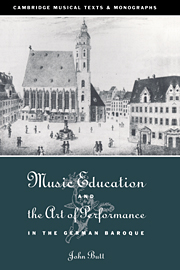Book contents
- Frontmatter
- Contents
- List of plates
- Preface
- Acknowledgements
- List of abbreviations
- 1 The establishment of Lutheran musical practice in the sixteenth century
- 2 The role of practical music in education c. 1600-1750
- 3 The contents, layout and style of instruction books
- 4 The development of performance practice and the tools of expression and interpretation in the German Baroque
- 5 Ornamentation and the relation between performer and composer
- 6 The decline of the Lutheran cantorates during the eighteenth century
- Notes
- Bibliography
- Index
3 - The contents, layout and style of instruction books
Published online by Cambridge University Press: 03 December 2009
- Frontmatter
- Contents
- List of plates
- Preface
- Acknowledgements
- List of abbreviations
- 1 The establishment of Lutheran musical practice in the sixteenth century
- 2 The role of practical music in education c. 1600-1750
- 3 The contents, layout and style of instruction books
- 4 The development of performance practice and the tools of expression and interpretation in the German Baroque
- 5 Ornamentation and the relation between performer and composer
- 6 The decline of the Lutheran cantorates during the eighteenth century
- Notes
- Bibliography
- Index
Summary
Any study relating to performance practice is based on primary sources – treatises, letters etc – which either singly or as a group give us some inkling of the context and specifics of historical performance. Problems often arise, though, for we cannot always be sure of the background of the writer concerned, his motives – benign or otherwise – or his relation to his contemporaries. Moreover, we are often equally unsure of the specific musicians to whom he addressed his remarks, or of who actually read his works. In the case of the present study there are certain factors which minimise these problems. First, the treatises concerned are, on the whole, chosen for their express relation to practical music instruction in a specific, semi-standardised education system; most writers belong to this system as practising teachers and musicians. There are sufficient similarities between the works and sufficient instances of direct plagiarism and reprinting to suggest that they offer a realistic picture of musical education and are thus not merely the speculations of a few eccentric cantors. Indeed some writers seem positively to be proud to have drawn their material from important authors; evidently adherence to tradition was often more desirable than originality. On the other hand, it must continually be stressed that the body of surviving literature is no substitute for what actually happened in public and private instruction; at most it offers a trace of what successive musicians and teachers themselves must have read, and – to a lesser and vaguer extent – a summary of what each may have consciously experienced in practice.
- Type
- Chapter
- Information
- Publisher: Cambridge University PressPrint publication year: 1994



